
Pairing winter heathers
Ideas and inspirations for planting heather in the garden in winter, either in the ground or in pots
Contents
Winter heathers bring colour and cheer with their lovely white or pink bell-shaped flowers. They have the advantage of blooming at a time when the garden is bare and few plants dare to showcase their aesthetic qualities.
Easy to grow, winter heathers can also effortlessly blend into the garden, in both small and large spaces. Plant these undershrubs in pots, as a shrub hedge, in borders, in light woodland, or in rockeries, alongside other plants with similar growing requirements.
Here are our 5 pairing ideas to inspire you with winter heather.
And to successfully cultivate heather, we invite you to explore our article: Heathers: planting, pruning, and care
In a planter to brighten up winter
Whether for dressing a windowsill, greening a balcony or terrace, heather can be accompanied by other small-stature plants to create a beautiful winter display.
You can choose to create a lovely range of pinks by combining, for example, pink heathers Erica (x) darleyensis ‘Kramer’s Rote’, ‘Winter Belles Tylou’ and ‘Darley Dale’ with autumn-flowering camellias in the same colour scheme. For instance, opt for Camellia sasanqua ‘Interlude’, a compact bush reaching 80 cm in all directions with its rose-shaped flowers. For a more rustic style, ‘Showa no Sakae’ or ‘Versicolor’ will also pair beautifully with our pink winter heather, complementing the start of its flowering.
If you wish to create a more colourful display, use white heathers like Erica (x) darleyensis ‘Silberschmelze’, which will highlight all other blooms. Pair them with creeping Gaultherias Gaultheria procumbens, small groundcovers that offer lovely decorative red berries in winter, creating a true Christmas atmosphere.
With decorative foliage, winter heather will also shine in a planter: create a display with graphic grasses like carex, evergreen heucheras or the less common sarcococcas, which will flower at the same time as our heathers.

Camellia versicolor, Erica darleyensis ‘Kramer’s Rote’ (photo Wikipedia) and Camellia ‘Showa no Sakae’
Read also
Heathers: planting, pruning and careIn a winter-flowering hedge
Due to their small stature, winter heathers will be ideal placed at the front of a flowering hedge, alongside other heather soil bushes.
Here again, our heathers can be accompanied by sasanqua camellias, as well as rhododendrons and azaleas. Opt for Japanese azaleas from the “Star Style” collection (‘White’, ‘Pink’, or ‘Violet’), which flower in autumn and spring. You can also choose Encore hybrid azaleas, with their double flowering in spring, autumn, and sometimes even summer (‘Sunburst’, ‘Lily’, or ‘Débutante’).
Complete with the fragrant flowering of daphnes, such as ‘Perfume Princess’ or Daphne odora ‘Marianni (Rogbret)’ with its beautiful variegated foliage.
Pieris such as ‘Little Heath Variegata’ or ‘Purity’ will also be good companions. Enjoy the decorative small fruits of skimmias throughout winter.
To add a sunny touch, mahonia and witch hazel will all be suitable.
Finally, if you have enough space, add a beautiful magnolia, which will reveal its large flowers in March-April, at the end of the winter heather flowering period.

Hamamelis ‘Feuerzauber’, Skimmia reevesiana (photo Wikipedia), Pieris ‘Little Heath Variegata’ (photo Megan Hansen), Erica darleyensis ‘Winter Belles Lucie’ and Daphne ‘Perfume Princess’
Discover other Heathers
View all →Available in 0 sizes
Available in 0 sizes
Available in 0 sizes
Available in 1 sizes
Available in 3 sizes
Available in 2 sizes
Available in 2 sizes
Available in 3 sizes
Available in 2 sizes
Available in 1 sizes
To dress the base of trees and bushes in light woodland
Most heathers naturally have a creeping habit, forming beautiful groundcovers that dress the base of taller plants and limit the growth of adventive plants (“weeds”).
In a woodland atmosphere with partial shade or at the base of deciduous trees, pair them with decorative foliage from ferns, of course, such as those from the genus Polystichum with their beautiful evergreen fronds. But also consider those of grasses, like Stipa barbata or molinia.
On their side, the needle-like foliage of conifers will also pair wonderfully with winter heathers: look towards dwarf varieties, such as creeping juniper, dwarf spruce, or Korean fir.
Heathers also pair perfectly with hellebores or Christmas roses, which reward us with their elegant flowers in winter. For example, cultivate varieties like ‘Madame Lemonnier’, ‘Double Fashion’, or ‘Walberton’s Rosemary’ to maintain a beautiful harmony of pink and white colours.
To add other touches of colour, consider autumn-flowering bulbs: pink Naples cyclamen or white ones, the uncommon Colchicum macrophyllum, or nerines. In winter, the lovely snowdrops, white or pink spring crocuses, hyacinths, and mini daffodils like ‘Reggae’ or ‘Toto’ will complete this lovely bright scene throughout the cold season.

Polystichum rigens (photo Guido), Helleborus ‘Double Fashion’, Erica darleyensis ‘Darley Dale’, and Picea abies ‘Little Gem’
Read also
Pruning heather: when and how?In a bed with almost continuous flowering
We always recommend growing heathers in masses to create a volumetric effect in the garden and achieve truly colourful carpets. You can also choose to grow heathers with staggered flowering periods, allowing you to enjoy them practically all year round.
Thus, pair winter-flowering heathers with the large arborescent heather ‘Great Star Le Vasterival’, which reveals its white bells in spring. In summer, the Cape heather and the heathers Calluna vulgaris ‘Alba’ and ‘Winter Chocolate’ with its incredible foliage of evolving colours will then take over.
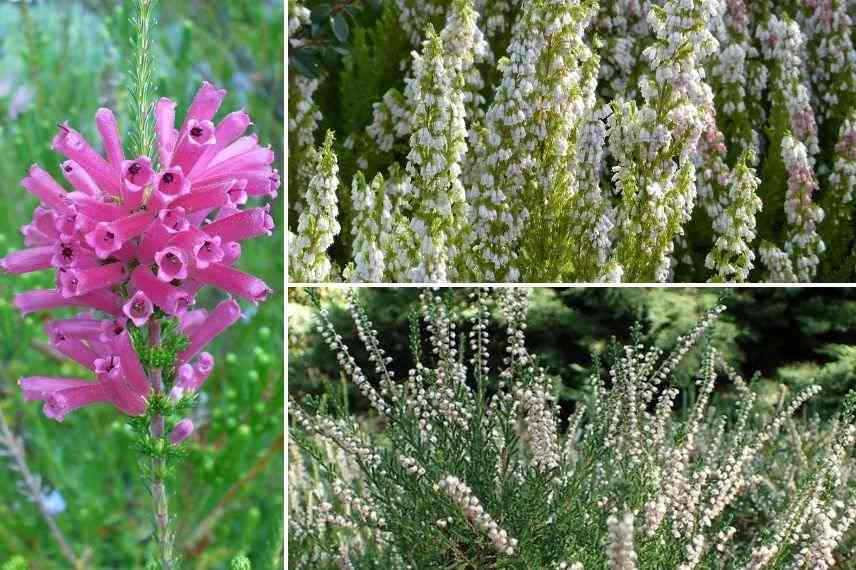
Erica verticillata (photo Andrew Massyn – Wikimedia), Erica arborea (x) veitchii Great Star® ‘Le Vasterival’ and Calluna vulgaris ‘Alba’
In a lovely flowering rockery
Some heathers that are broader than they are tall are particularly suited for use as groundcover. Preferring well-drained soils and sunny exposures, they are ideal for dressing a slope or a not-too-dry rockery. This is the case, for example, with Erica darleyensis ‘Ghost Hills’, ‘Darley Dale’ or ‘White Perfection’, which measure about 40 cm in height and 60 to 70 cm in spread.
Pair them with dwarf creeping conifers, such as Juniperus, Sawara cypress or creeping Siberian cypress.
For a graphic touch, add sedums with evergreen foliage, such as creeping stonecrop ‘Lemon Ball’, Sedum cauticola ‘Lidakense’ or the vibrant sedum ‘Mr Goodbud’, whose bright pink flowering lasts until autumn.
Also consider the must-have saxifrages for rockeries. For example, choose from Saxifraga cortusifolia ‘Black Ruby’, ‘Shiranami’ or Saxifraga fortunei ‘Sugar Plum Fairy’, all of which bloom in autumn in pink or white, creating a lovely colour harmony with our winter heathers.
The hardy geraniums for rock gardens that flower until frost will also make good companions: opt for ‘Bob’s Blunder’, ‘Orkney Cherry’ or ‘Mavis Simpson’.
Finally, the small bulbs of Iris reticulata, flowering in late winter, will complete this floral picture.
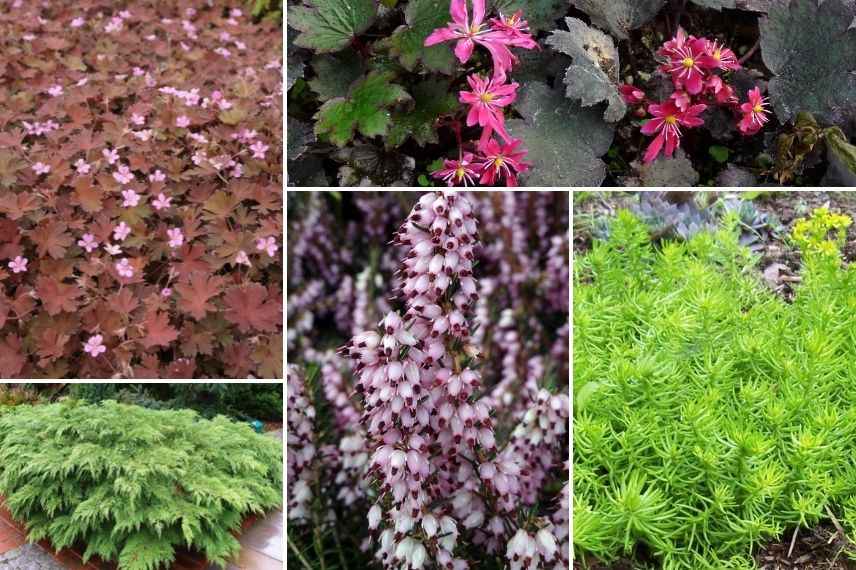
Geranium ‘Bob’s Blunder’, Saxifraga ‘Black Ruby’, Microbiota decussata, Erica darleyensis ‘Ghost Hills’ and Sedum ‘Lemon Ball’ (photo inaweofgod’s creation)
- Subscribe!
- Contents
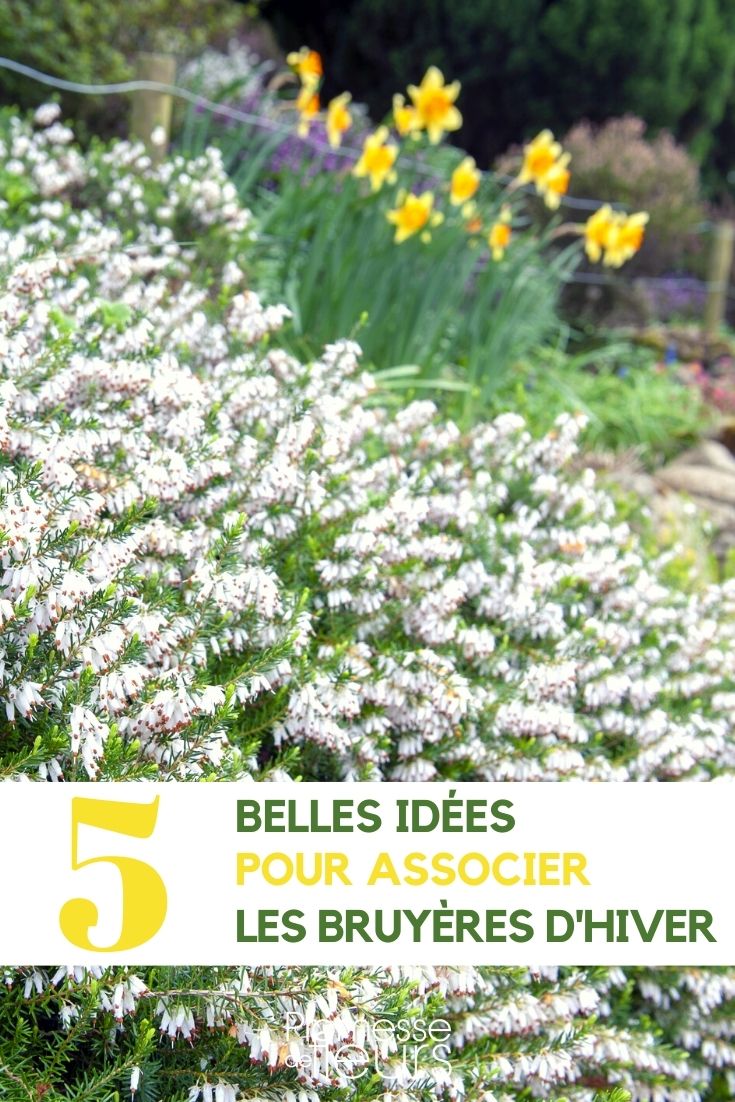































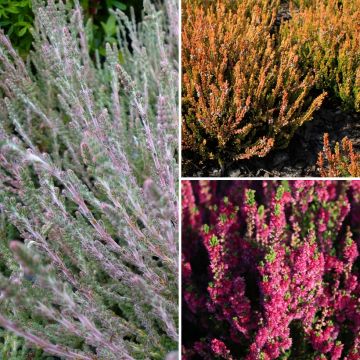
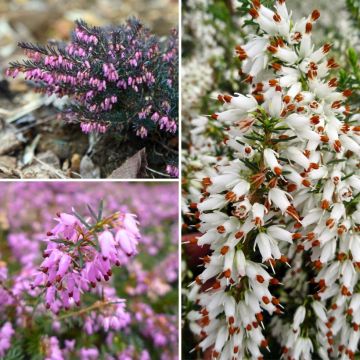



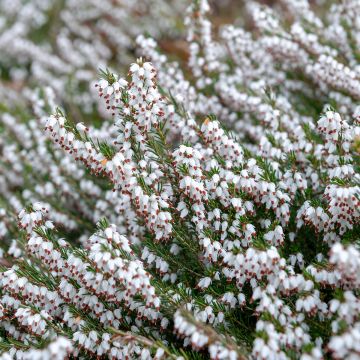

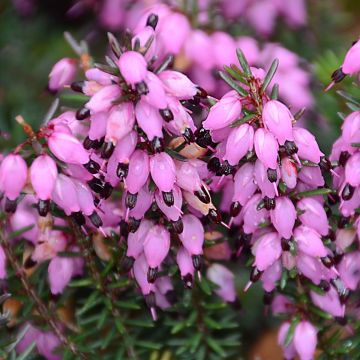
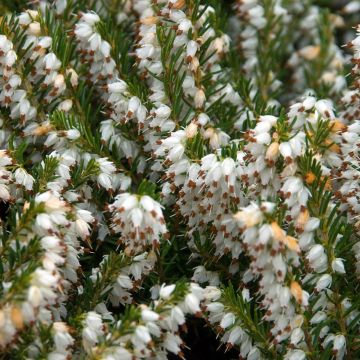
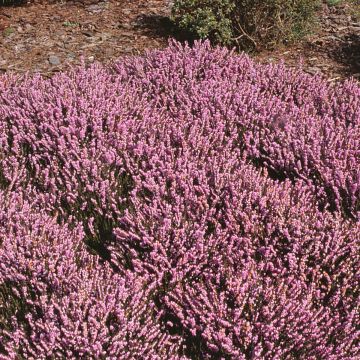
Comments